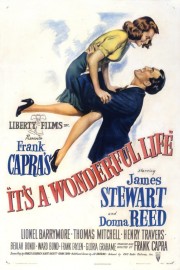It’s a Wonderful Life
Can you believe it wasn’t until 2000 that I first saw the entirety of Frank Capra’s holiday classic “It’s a Wonderful Life?” It was that Thanksgiving, in fact, making it fitting that I finally review it on a Thanksgiving 10 years later.
This was one of those films that helped me get my emotional equilibrium back after my grandfather’s death. I’ll be honest, I wasn’t sure what I was in for beyond the scenes and moments I’d seen in various films and other sources over the years.
What I got was pure magic. Capra makes the best kind on inspiring film, which takes its’ characters to the edge, making the payoff even better. The dark places Capra and James Stewart- in one of his best performances- take George Bailey to, including contemplating suicide when his absent-minded uncle misplaces a large deposit on Christmas Eve. The sacrifices the story asks him to make in order to make other people’s dreams come true. Capra- working from a screenplay he worked with by Frances Goodrich, Albert Hackett, and Jo Swerling- is superb at painting Bailey as an all-American hero of the everyman…
…which is just the type of role Stewart excelled in so well. From his performance as Mr. Smith for Capra years before to even the morally-complex characters he would play later for Hitchcock, Stewart was an actor easily identifiable with. He navigates George’s emotional turmoil effortlessly, from the high times of his early flirting with future wife Mary (Donna Reed) while she’s caught naked in a bush after a dance to his dealings with old man Potter (Lionel Barrymore as one of the great movie villains) to his eventual redemption when Angel First Class Clarence (Henry Travers) shows him what life in Bedford Falls would be like without him during the film’s final, darkest moments.
It’s not a pretty sight. His brother Harry drown when he was a child because George wasn’t there to save him. Mary is an old maid who works at the library. His childhood boss Mr. Gower spent 20 years in prison because George wasn’t there to point out that he’d put poison in a young boy’s medicine. And Potter runs the entire town because George wasn’t there to take over his father’s old Building & Loan when he passed.
It’s hard to see the impact of our life on others when we are at our lowest. Unfortunately, we’re not really offered the opportunity George is offered here. Like Scrooge in “A Christmas Carol,” he requires a guiding spirit to see where he’s gone wrong in his thinking. Fortunately, unlike the ghosts that haunt Scrooge, Clarence is a benevolent angel who offers compassion to a man who truly deserves it in his moment of dire need.
This is the best kind of uplifting movie. It doesn’t paint the world as all roses and snowflakes, and it traffics in genuine feeling instead of cheap sentiment. And there are so many wonderful moments to remember. “No man is a failure who has friends.” “A toast to my big brother George. The richest man in town.” The sock hop and George and Mary going in the pool. The corny twinkling stars at the beginning. The freeze-framed first look at Stewart’s George as a young man. His passionate, fierce phone talk leading to a passionate kiss with Mary. And so many more.
Life isn’t always as wonderful. But fewer movies live up to their title more. No wonder it’s become one of the most enduring of classics.










